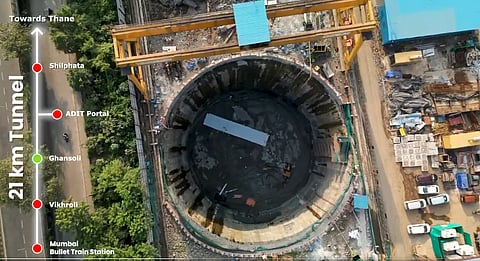India's bullet train: Excitement builds as tunnel work kicks off
21-km long high-speed rail tunnel to redefine Subcontinent's transportation landscape

Hold onto your hats (or train tickets), because India is about to break some serious records — and it’s happening underwater.
The subcontinent’s first underwater high-speed rail tunnel is taking shape. And it’s about to transform the nation’s transportation landscape.
Ambitious project
The National High-Speed Rail Corp Limited (NHSRCL) has officially kicked off construction on one of the most ambitious rail projects ever to grace the globe: a 21-km (13-mile) underwater tunnel.
India's own "Shinkansen" (with a top speed of 320 km/h) is estimated to cost about $15 billion (Rs1.1 lakh crore).
Excitement is building up on is the nation's first high-speed rail set to cut travel time between Mumbai and Ahmedabad, two of India’s most bustling cities from 10 hours to just over 2 hours.
That's a 5x improvement in travel efficiency. NHSRCL recently posted on X about the progress on the tunnel, from Mumbai to Shilphata.
High-speed, high-tech, green
This isn’t just any tunnel. This project is as high-tech as it is eco-friendly.
So, let’s dive in (pun intended) and unpack this thrilling journey:
Also Read: Bullet train project gains momentum: All nine river bridges between Vapi and Surat completed
This is not your average train ride – it’s the tunnel to the future: The underwater segment of the rail line is nothing short of groundbreaking, literally and figuratively.
The project spans a jaw-dropping 508 km (315.66 miles), but it’s the 21-km (13-mile) stretch of rail that will be snaking its way underneath the water that’s getting all the attention.
Why? Because it's India's very first underwater rail tunnel.
Not only will this tunnel connect two major cities, but it’s also designed to have minimal impact on local wildlife.
Nearby ecosystems, like the flamingo sanctuary and mangroves, are getting special treatment—these precious areas are home to biodiversity, and the mangroves even help tackle climate change by sucking up CO2 and transforming it into bicarbonate.
High road
So, NHSRCL has decided to take the high road—literally—by building 92 per cent of the line on elevated viaducts and bridges.
That’s right—no water or wildlife will be blocked, and nature will continue its happy flow.
Engineering marvels, eco-warriors
Now let’s talk about the cool tech.
The rail line will use E5 Series Shinkansen bullet trains (think Japan-level precision) that run on electricity, so forget about polluting fumes.
This system is as green as it gets.
And when it comes to speed, we’re talking two hours and seven minutes to travel between Mumbai and Ahmedabad. It currently takes about 10 hours 1 minute (522.4 km) via NH 48, as per Google maps.
With the high-speed train, it’s blink, and you’ll be there.
Shri Rajendra Prasad, the managing director of NHSRCL, put it perfectly: “Construction of 21 kilometers of tunnel is one of the most challenging contracts of the Mumbai-Ahmedabad HSR corridor, which includes construction of the country’s first twin-track undersea rail tunnel of 7 kilometers at Thane Creek.” Cue dramatic music!
This tunnel isn’t just a technical triumph; it’s a win for the planet, too.
Trains on the HSR system will produce only 4 kilograms of CO2 per 100 passengers per kilometer, compared to the 14 kg produced by cars or the 17 kilograms from airplanes.
Talk about eco-conscious commuting.
Solar Power and Water Savers: The Green Future of Travel
This isn’t just a flashy rail project—it’s a blueprint for a greener future.
NHSRCL is going all out with solar panels on stations and maintenance depots, cranking up clean energy production.
Plus, with rainwater harvesting systems in place, the whole operation is designed to conserve water like an eco-friendly superhero.
India joins the global green rail revolution
India’s high-speed rail isn’t alone in its quest to revolutionize transportation.
From Spain’s extensive rail network to the proposed Shinkansen line between Dallas and Houston, the world is getting on track for a more sustainable future.
India’s 2028 target for completing the Mumbai-Ahmedabad line might sound far off, but this trailblazing project is already setting the stage for the next generation of eco-friendly travel.
So, whether you’re an avid rail fan, an environmental warrior, or just someone who likes to imagine how cool a train ride could be, buckle up—India’s underwater high-speed rail adventure is about to make history.
Sign up for the Daily Briefing
Get the latest news and updates straight to your inbox



